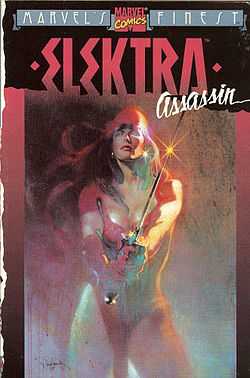Elektra: Assassin
| Elektra: Assassin | |
|---|---|
 Cover of Elektra: Assassin trade paperback, published in 2000. | |
| Publication information | |
| Publisher | Epic Comics |
| Schedule | Monthly |
| Format | Limited series |
| Genre | |
| Publication date | August 1986 – March 1987 |
| Number of issues | 8 |
| Main character(s) | Elektra |
| Creative team | |
| Writer(s) | Frank Miller |
| Artist(s) | Bill Sienkiewicz |
| Letterer(s) | Jim Novak |
| Colorist(s) | Bill Sienkiewicz |
| Editor(s) |
Daniel Chichester Archie Goodwin |
| Collected editions | |
| Elektra: Assassin | ISBN 0-87135-309-1 |
| Elektra by Frank Miller Omnibus | ISBN 0-7851-2777-1 |
Elektra: Assassin is an eight-issue limited series published by Epic Comics, an imprint of Marvel Comics, between August 1986 and March 1987. Written by Frank Miller and illustrated by Bill Sienkiewicz, Elektra: Assassin satirizes ultra-violence, politics, comic book clichés like ninjas and cyborgs, and the portrayal of women.[1]
Publication history
Frank Miller and Bill Sienkiewicz were at the height of their popularity when this series was released, shortly on the heels of Miller's hugely successful Batman: The Dark Knight Returns, and Miller & Sienkiewicz's Marvel Graphic Novel Daredevil: Love and War.
As with Ronin and Born Again, Miller wrote the series with the full script method.[2]
As with Daredevil: Love and War, Sienkiewicz illustrated Elektra: Assassin using watercolors as opposed to the traditional pencilling/inking method. His exaggerated art was unique amongst mainstream comics of the time, bringing to mind the illustration style of adult-oriented comics magazines like Heavy Metal.
Plot summary
The story starts out with Elektra in a mental institution in South America, attempting to recover her memory. The first issue is very disjointed, as Elektra pieces together jumbled memories ranging from the murder of her mother, molestation by her father (which she says is actually an invented memory), to more recent events such as an assassination she carried out. This led her to discover the existence of "The Beast," which controls people by forcing them to drink its milk. At first, The Beast's motives are unclear, but it is gradually revealed that it is attempting to bring about a nuclear war. When its initial plans fail, it launches the presidential campaign of Ken Wind (with a face resembling a grainy Dan Quayle photograph, whose resemblance is a coincidence, according to Sienkiewicz, since it is a Sienkiewicz self-portrait.)[3] Wind proves extremely popular, through various platitudes which disguise his evil nature; when Wind takes over, he intends to launch a nuclear attack on the Soviet Union, bringing about mutually assured destruction.
Elektra uses her psychic powers to escape, running afoul of a S.H.I.E.L.D. agent named Garrett. Garrett, an alcoholic, feels ashamed and becomes obsessed with Elektra, but she manages to stay one step ahead of him. She traps him in a building which is blown up, and most of his body is destroyed. S.H.I.E.L.D.'s experimental cybernetics division builds him a robotic body and attaches his head. His psychic bond with Elektra continues to grow, and he eventually realizes he is powerless against her. She sets out to stop the Beast, killing various subordinates and several S.H.I.E.L.D. agents in the process. In response, Nick Fury sends Chastity McBryde, a strictly by-the-book agent. Perry, a sociopath who was Garret's former partner, has now also been turned into a cyborg. Chastity learns of Perry's suppressed sociopathic criminal history, and informs Fury, but Perry manages to escape before S.H.I.E.L.D can deactivate him. Perry is extremely dangerous and eventually comes under the service of The Beast.
The Beast manages to get Wind elected president, but Elektra thwarts the plan with her psychic powers and ninja skills. In a final confrontation, Elektra manages to injure The Beast, terminate Perry, and transfer the mind of Garrett into Ken Wind and vice versa before she and Garrett are captured by S.H.I.E.L.D. As Chastity is giving her final report to the President about what happened, we realize that in the end, Garrett, in the body of Wind, is the President. Elektra, using her psychic powers yet again, manages to escape S.H.I.E.L.D after she has recovered, by placing her mind in one of the blue helper dwarfs, knocking out Chastity and then releasing her own body.
Rating
Miller's story wasn’t considered appropriate for the Comics Code Authority seal. Instead, Elektra: Assassin was released under the Marvel imprint Epic Comics, known for producing material more appropriate for adults. It was also not sold on newsstands, but only through speciality stores.
Continuity
It is deliberately left vague whether the events in Elektra: Assassin take place prior to Elektra's initial appearances in Daredevil, or whether it details a subsequent resurrection. Former Marvel editor Mary Jo Duffy, in the introduction to the Elektra omnibus, claims that Frank Miller conceived the series as taking place before Elektra's Daredevil appearance.[4] Subsequently, the series has been dismissed by many as non-canonical.[citation needed] However, events in Elektra: Assassin are alluded to in writer Garth Ennis' 2000s Punisher run.
Collected editions
The series has been collected into a trade papeback:
- Elektra: Assassin (268 pages, Marvel, 1989, ISBN 0-87135-309-1, Panini Comics, 2005, ISBN 1-904159-89-3)
It was also included in the 2008 hardcover Elektra by Frank Miller Omnibus (ISBN 0-7851-2777-1).
Awards
- 1988: Nominated for "Best Finite Series" Eisner Award[5]
Notes
- ↑ Burgas, Greg (January 21, 2007). "Comics You Should Own - Elektra: Assassin". Comics Should Be Good. Comic Book Resources.
- ↑ Zimmerman, Dwight Jon (July 1986). "Archie Goodwin". Comics Interview (36) (Fictioneer Books). p. 39.
- ↑ Mithra, Kuljit. Interview with Bill Sienkiewicz, Daredevil: ManWithoutFear.com (January 2000).
- ↑ Duffy, Mary Jo. "Introduction," Elektra by Frank Miller Omnibus (Marvel, 2008).
- ↑ 1988 Will Eisner Comic Industry Award Nominees and Winners, Comic Book Awards Almanac
References
- Elektra: Assassin at the Grand Comics Database
- Elektra: Assassin at the Comic Book DB
External links
| ||||||||||||||||||||